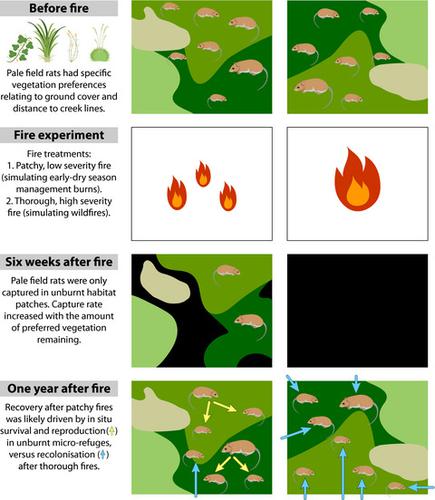当前位置:
X-MOL 学术
›
J. Appl. Ecol.
›
论文详情
Our official English website, www.x-mol.net, welcomes your
feedback! (Note: you will need to create a separate account there.)
Unburnt habitat patches are critical for survival and in situ population recovery in a small mammal after fire
Journal of Applied Ecology ( IF 5.0 ) Pub Date : 2021-02-09 , DOI: 10.1111/1365-2664.13846 Robyn E Shaw 1, 2 , Alex I James 3 , Katherine Tuft 4 , Sarah Legge 5, 6 , Geoffrey J Cary 6 , Rod Peakall 1 , Sam C Banks 6, 7
中文翻译:

未烧毁的栖息地斑块对于火灾后小型哺乳动物的生存和原地种群恢复至关重要
更新日期:2021-02-09
Journal of Applied Ecology ( IF 5.0 ) Pub Date : 2021-02-09 , DOI: 10.1111/1365-2664.13846 Robyn E Shaw 1, 2 , Alex I James 3 , Katherine Tuft 4 , Sarah Legge 5, 6 , Geoffrey J Cary 6 , Rod Peakall 1 , Sam C Banks 6, 7
Affiliation

|
- Fire drives animal population dynamics across many ecosystems. Yet, we still lack an understanding of how most species recover from fire and the effects of fire severity and patchiness on recovery processes. This information is crucial for fire-mediated biodiversity conservation, particularly as fire regimes change globally.
- We conducted an experiment to test whether post-fire recovery is driven by in situ survival or recolonisation, and to determine whether this varies with fires of increasing percentage area burnt (burn cover) and severity. We used the pale field rat Rattus tunneyi as a model, because it represents the extinction process for a suite of mammal species suffering population collapse across Australia's northern savannas. Our treatments spanned a gradient from patchy, low severity fires (simulating early dry season management burns) to thorough, high severity fires (simulating wildfires). We performed capture–mark–recapture, vegetation and aerial surveys before, 6 weeks after and 1 year after fire.
- Six weeks after fire, pale field rats were only captured in unburnt patches of vegetation, and capture rates were proportional to the amount of unburnt habitat. One year later, both vegetation and pale field rat populations recovered across all sites. However, population recovery after low severity fires was likely achieved through in situ survival and reproduction in unburnt micro-refuges, compared to recolonisation driving recovery after high severity fires.
- Synthesis and applications. Pale field rat persistence is strongly dependent on the retention of unburnt habitat patches within fire-affected areas. Management strategies that increase micro-refugia within burnt areas may facilitate pale field rat population recovery. Globally, building recovery mechanisms into fire management will be vital for supporting the long-term persistence of fire-affected species.
中文翻译:

未烧毁的栖息地斑块对于火灾后小型哺乳动物的生存和原地种群恢复至关重要
- 火灾推动了许多生态系统中的动物种群动态。然而,我们仍然缺乏对大多数物种如何从火灾中恢复以及火灾严重程度和不均匀性对恢复过程的影响的了解。这些信息对于以火为媒介的生物多样性保护至关重要,尤其是在全球范围内火势发生变化的情况下。
- 我们进行了一项实验,以测试火灾后的恢复是由原地生存还是重新定殖驱动的,并确定这是否随着燃烧面积百分比(烧伤覆盖率)和严重程度的增加而变化。我们使用苍白的田鼠 Rattus tunneyi作为模型,因为它代表了澳大利亚北部稀树草原遭受种群崩溃的一系列哺乳动物物种的灭绝过程。我们的处理跨越了从零散的低严重性火灾(模拟早期旱季管理烧伤)到彻底的高严重性火灾(模拟野火)的梯度。我们在火灾前、火灾后 6 周和 1 年后进行了捕获-标记-重新捕获、植被和空中调查。
- 火灾发生六周后,苍白的田鼠只被捕获在未燃烧的植被斑块中,捕获率与未燃烧的栖息地数量成正比。一年后,所有地点的植被和苍白的田鼠种群都恢复了。然而,与高严重性火灾后的重新定植推动恢复相比,低严重性火灾后的种群恢复可能是通过在未烧毁的微型避难所中的原位生存和繁殖来实现的。
- 合成与应用。苍白的野外老鼠的持久性很大程度上取决于在受火灾影响的地区内未燃烧的栖息地斑块的保留。在烧毁区域内增加微型避难所的管理策略可能会促进苍白的田鼠种群的恢复。在全球范围内,在火灾管理中建立恢复机制对于支持受火灾影响物种的长期存在至关重要。











































 京公网安备 11010802027423号
京公网安备 11010802027423号